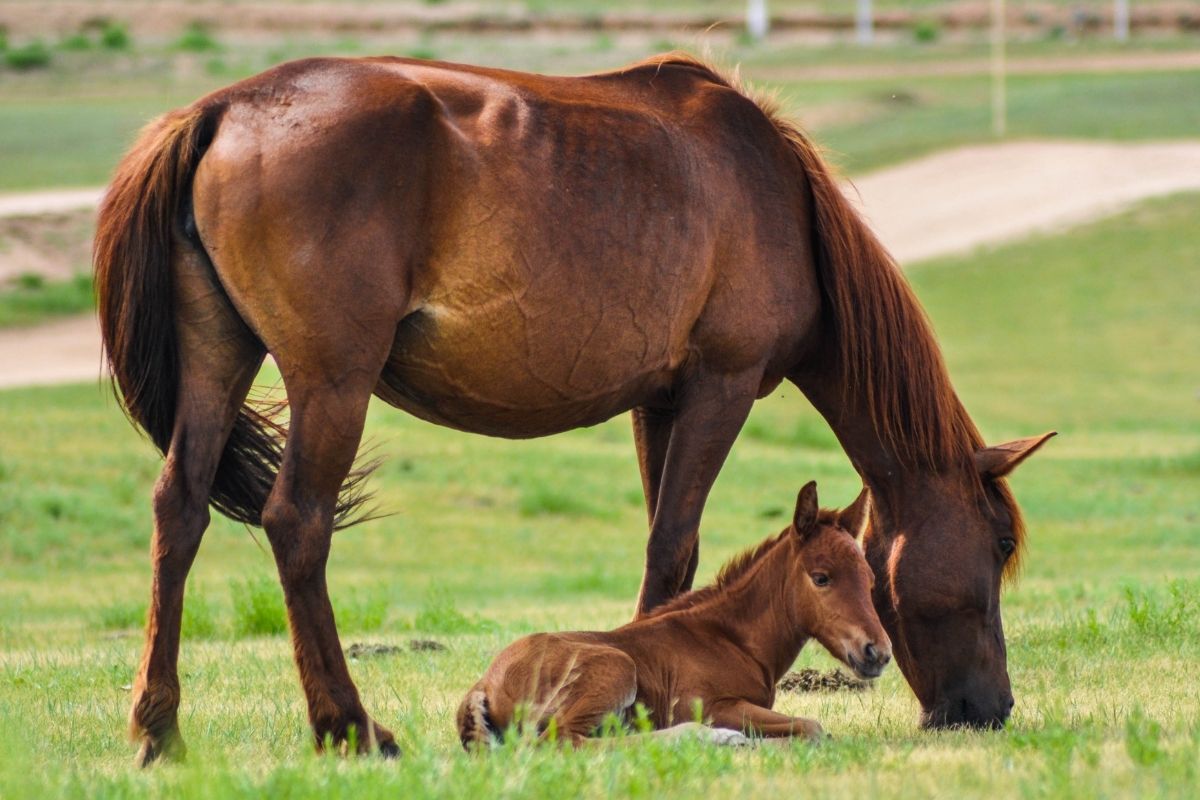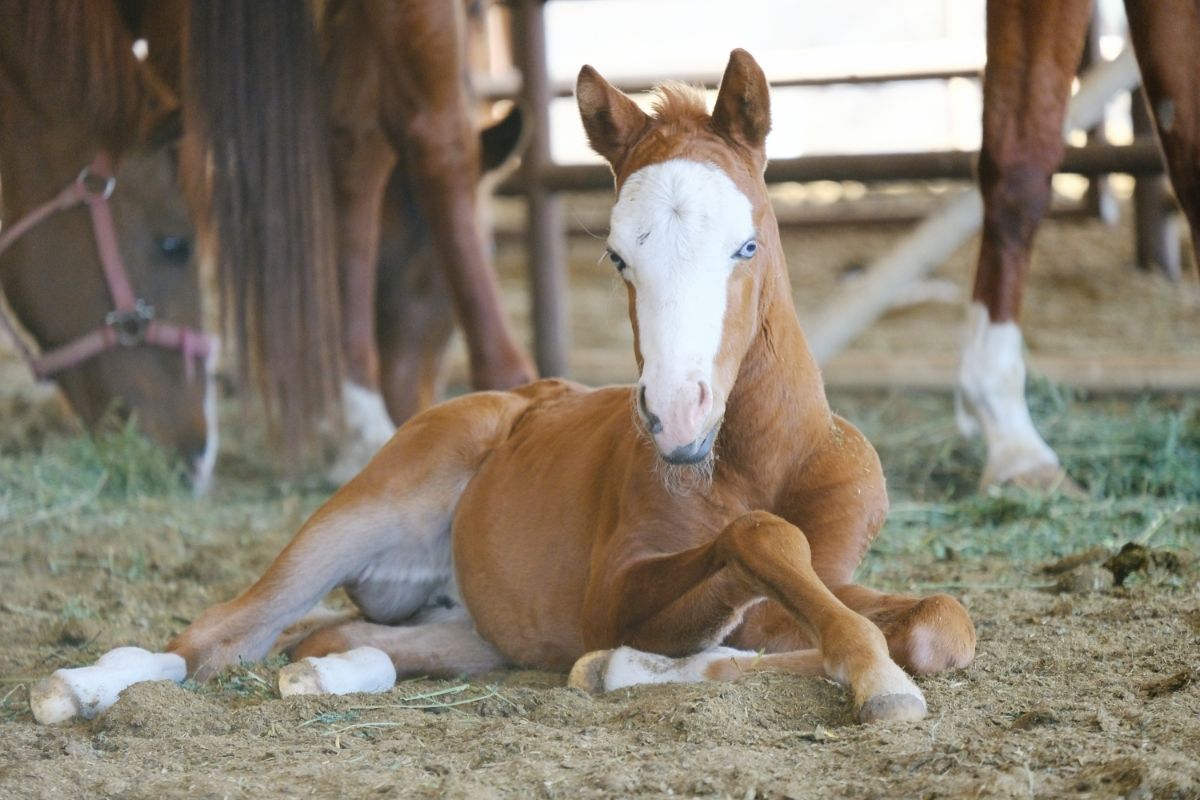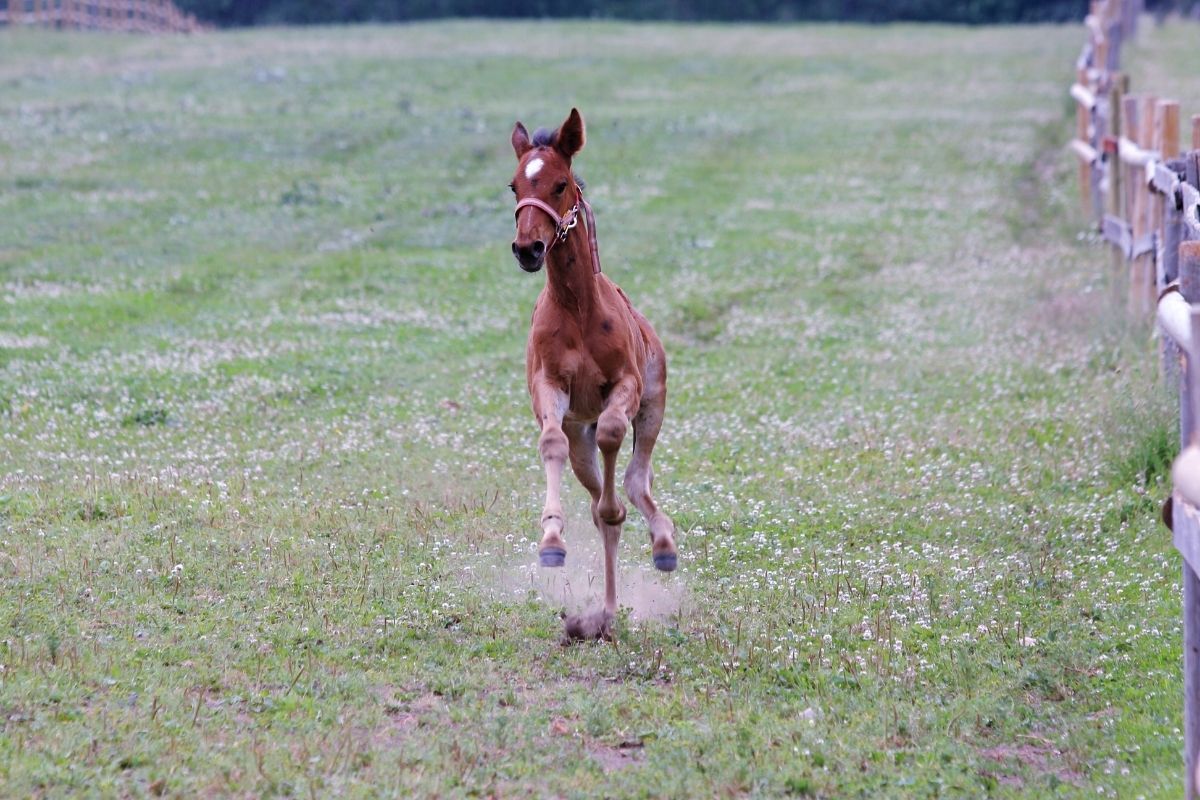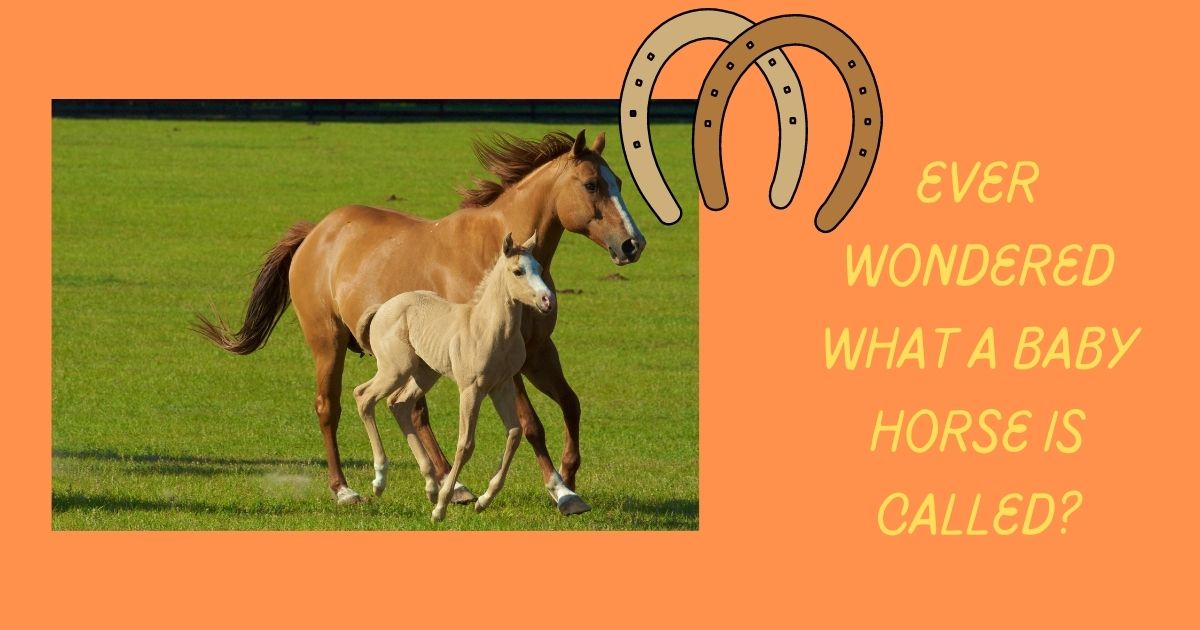Are Ponies Considered Young Horses?
Is your horse having a baby? Wondering what a baby horse is called? A baby horse is called a foal. Horses are classed as ponies. Ponies are little horse breeds that, when fully grown, appear smaller than other horse types.
A horse’s height is measured in hands (the area between its neck and back). Horses with a height of 9 inches (2.5 centimeters) or more are referred to as horses. The industry considers mature horses shorter than 14 hands (142 centimeters) to be ponies.

What a Baby Horse is Called
Until they reach the age of one year, all baby horses are referred to as foals, regardless of gender. You may be asking yourself; what is a female baby horse called? A female foal is called a filly horse, and a male foal is called a colt horse. Until they reach the age of four, most horse owners refer to colts or fillies.
Colt and filly are terms used to describe juvenile horses in the same way that boy and girl describe people. Other horse words, such as foal, relate to them by their age or stage of life. For example, a foal that has recently quit nursing is referred to as a weanling, regardless of gender.
Around the age of six months old, foals quit weaning. Horses are referred to as yearlings once they have been weaned. A yearling is a horse that has turned one year old but has not yet turned two. This word also refers to horses of either sex.
Yearling colts are male horses who have not yet reached the age of two, while yearling fillies are female horses who have not yet reached the age of two. Horses are called colt (male) or filly (female) until they reach the age of four.
Male horses become stallions after four years, and female horses become mares. A gelding is a male horse that has been castrated. Different names refer to horses that are predominantly utilized for breeding.
A stud is a stallion used for breeding, while a mare is a broodmare. Either “live cover” or artificial insemination can be used to conceive a foal (baby horse). Horses mate in the wild and pastures. On the other hand, domesticated horses are frequently selectively bred in a controlled environment under the supervision of a veterinarian or owner.
A brand-new foal comes into the world with zeal. Within the first hour, the newborn horse should be able to stand, suckle for two hours, and pass its first stool within three hours. The “1-2-3 Rule” is the name for these steps. The foal’s dam intuitively understands the value of colostrum to her foal.
She will immediately encourage her kid to stand and nurse. Shortly after birth, the capacity to suck the mare’s teat is apparent.
After their first nursing, foals will nurse every thirty minutes or so. Keep an eye on your horse; failure to nurse regularly could indicate a problem. Has a veterinarian examined your foal as soon as possible after birth?
When is a Baby Horse Weaned?
The best timing to wean a foal is a point of contention. Foals can be weaned safely from three months old to address the precise issue. However, by the third month of its life, a foal has probably foraged enough grass to eat a balanced diet.
The foal no longer requires his mother’s milk to stay healthy due to nourishment from other sources. His mother, too, could benefit from a vacation from nursing her youngster. She could rest. The following inquiry is: when is the ideal time to wean a foal? This is where the gray region begins.
According to certain research, horses weaned at three months have a higher risk of developing behavioral issues and are more likely to suffer orthopedic illnesses. The optimal weaning technique includes having other horses with the foal to alleviate the anxiety of separation from their mother.
You should include some barren mares and foals in this group of horses. The foals give the mares playmates discipline and manners. Make sure the mare and baby pony are separated so they can’t touch one other. Separate the horses for at least one month.
Can You Ride a Baby Horse?
Certainly not! Before being ridden, baby horses must be at least four years old. Their bones have not fully matured before this time, and riding them puts them at risk of injury. Before placing a lot of weight on a horse, make sure its bones can handle it.
Before a horse is ridden for the first time, a veterinarian must examine its growth plates in the knees to confirm that they can support the weight of a rider. The length of time it takes for a horse to mature physically such that you can ride it is determined by several factors, including the horse’s breed and physical development.
Yearling quarter horses are frequently broken for riding and begin intense training as two-year-olds. Horses of larger breeds aren’t ridden until they’re three years old, and some kinds aren’t ridden until they’re four. Before you may ride your horse, it must be physically developed to a particular extent, independent of the breed.
Before you start riding a horse, you should get it checked out by an experienced horseman. Riding a horse too young might result in catastrophic leg injuries. You should know when a horse has reached full maturity and is thus ready for riding.

Should Young Horses be Bred?
You can breed your filly horse even if she is two years old. However, she should be healthy and in good shape. Some people breed their horses when they are two years old, while others wait until three. Mares will produce offspring until they are in their early twenties. The horse’s ability to breed, on the other hand, diminishes with age.
In addition, an older mare who has just reproduced has a better probability of becoming pregnant again than one who has been sterile for the previous breeding seasons. Furthermore, waiting until your mare is older to mate does not guarantee that she will be highly fruitful when she does mate. It can be challenging for elderly mares to conceive.
Why is a Mare’s Udder so Full?
The first indicator that your horse is preparing to give birth is full udders. Your mare’s udders will occasionally fill during pregnancy, but they will return to their standard size after some time. If you’re in the final month of pregnancy and your mare’s udders stay full all day, you should know the baby is on the way, so don’t leave her alone.
If you look closely, you can see the baby’s tummy begin to shrink as it prepares to exit the mother’s womb. The muscles around the hips and buttocks may also relax and contract. In addition, your mare’s nipples may begin to leak colostrum after the baby is born. Colostrum is the type of milk produced by a horse shortly after giving birth.
Assist the newborn horse in getting to the teats to suckle. Do not allow the dam to lose a significant volume of colostrum. This foremilk is rich in vitamins, antibodies, and nutrients that the foal requires to grow and be healthy.
If your horse is losing a lot of colostrum, try collecting it and freezing it for later use. Also, keep an eye on your horse to see whether she stops bleeding after a while. If it doesn’t, consult your veterinarian.
Dystocia is the medical word for a foaling condition. It’s a life-threatening ailment that can kill both the mare and her foal. Even if she survives, she may be childless in the future.
A large foal or a foal in an uncomfortable position is the most common cause. Signs that foaling isn’t going as planned include water breaking, and the foal is not delivered. If you observe any of these symptoms, see a veterinarian right away.
Slow the mare’s uterine contractions by getting her up on her feet. The placenta may come out before the water breaks. The foal must be cut open to get it to breathe.
Issues Associated With Baby Horses
You can recognize several issues in baby horses’ early years of development. The following are the most common:
Nursing Refusal
Every one to two hours, you should feed newborn horses. It might be an issue if a foal does not suckle as often as it should or does not suckle at all. Nutrient intake is critical for any infant, as it guarantees that the baby horse grows up healthy. If a foal refuses to nurse, you must establish a strategy to ensure that it receives the nutrition it needs.
Even if the foal is well nursed, it may not absorb the necessary nutrition. Low-quality colostrum is one of the main reasons for this. Have the foal’s serum Immunoglobulin Gene (IgG) levels measured by a veterinarian.
Low blood sugar levels of less than 400 mg/dl are considered hazardous and should be handled. If the mare is vaccinated a month before birth, you can avoid this problem.
Stomach Ache
Abdominal discomfort may indicate that the newborn horse suffers from a digestion problem. It could potentially be a sign of a bladder rupture. Consult a veterinarian about it.
Constipation
Constipation can be indicated by difficulty passing stool. This can lead to impaction or significant complications requiring veterinary attention, such as colic.
Leg Anomalies
Some foals are born with limb deformities that make it challenging to live their lives normally. Flexural contractures and flexural tendons are examples of these issues that you should correct as soon as possible to allow the foal’s limbs to grow strong and healthy.
See a veterinarian specializing in foal orthopedics if you discover malformations in your baby horse’s limbs.
How to Care for Baby Horses
As soon as the foal is born, check to see if it is breathing OK. After a few seconds, a newborn horse should begin breathing independently. If your foal doesn’t start breathing straight away, rub its nostrils with a towel or some hay to open them up. Lead it to the dam’s teat if the newborn horse is struggling.
Most foals will stand up and begin suckling within two hours of being born. If your newborn horse has problems finding the mother’s teat, assist them. If the ground is moist or slippery, place extra hay near the youngling.
A baby horse will attempt to stand up within fifteen minutes of being born. Even if it appears to be struggling, do not assist it in standing; otherwise, you will irreparably harm it. Instead, surround it with extra bedding to keep the ground from becoming slick. Then, within twenty-four hours after the foal’s birth, get it checked by a veterinarian.
Having your foal examined by a veterinarian as soon as it is born might help you detect birth defects that you might not be able to detect on your own. Please keep track of significant milestones in the first three hours, as the veterinarian may inquire about them.
When do Baby Horses Stand for the First Time?
Within the first hour, the newborn should be able to stand, suckle for two hours, and pass his first stool in three hours. The “1-2-3 Rule” is the name for these steps.
The foal’s dam intuitively understands the value of colostrum to her foal. She will immediately encourage her kid to stand and nurse. Shortly after birth, the capacity to suck the mare’s teat is apparent.
After their first nursing, foals will nurse every thirty minutes or so. Keep an eye on your horse; failure to nurse regularly could indicate a problem. Has a veterinarian examined your foal as soon as possible after birth? You should keep an eye on your new foal after it is born and be able to answer the following questions:
- How long did the foal stand after birth?
- How frequently does the foal nurse?
- Is the size of the mare’s udders reduced when the foal feeds? Examine the udders before and after nursing to see if the foal has milk on its nose and face.
- Have you seen the foal’s first bowel movement? You can provide an enema if your foal hasn’t had its first bowel movement. Call a veterinarian if the treatment doesn’t work on your foal).

Interesting Facts on Baby Horses
If you’ve ever been around a foal or have only seen them in photos and movies, it’s crucial to understand that there’s more to these enormous baby horses than their lovely sweetness. So continue reading to discover fascinating facts about all foals:
- Foals are only foals for a short time: A horse is only considered a foal for the first twelve months of its existence. After that, it can be called a colt until it is two-three years old if it is male. If it’s a female, the young horse is a filly until it reaches four years old. After that, a horse is considered an adult, and their foal days are a distant memory.
- Most foals are born in complete darkness: Horses are prey animals, and they’ve evolved some very remarkable biological defenses against predators. Even the way and when they give birth has changed to ensure their safety. Most foals are born between midnight and 6 AM when it’s still dark. This is because when the shadows are on your side, it’s simpler to hide a newborn foal from predators.
- Mares are often only in labor for a short period, which adds to their protection: They’re vulnerable during birth, and they want to get through it as quickly as possible so they can focus on avoiding danger. So it’s not uncommon for hardworking folks to miss a momentous occasion because they took a quick toilet break or went for a coffee run.
- A foal’s legs are 80-90% fully developed at birth: There’s a physiologic reason why foals have lengthy, gangly legs when they’re born. Long legs help them keep up with their herd during the first several months of life when they must keep up or risk being left behind. They must flee from predators and travel in search of food and water. Their long legs assist them in surviving, even if they make them clumsy. The rest of their body catches up to their long legs as they grow, and their legs remain roughly the same length.
- Only two hours after birth, foals can stand: It takes nearly one year for a human newborn to develop the muscle and balance necessary to stand independently. On the other hand, foals may stand on their feet in less than two hours. Only a half-hour after birth, some newborns begin nursing and wandering around. Another survival attribute is their rapid growth from sitting to standing, strolling, and even galloping. If their mother detects danger, they must be able to move. Foals must also stand to nurse and acquire their first essential swallows of nutrition.
- It’s common for newborn foals to have bowed legs, a condition known as “windswept”: When a more miniature mare gives birth to a larger foal, bowed legs are more frequent. It’s typically nothing to be concerned about when this happens. Due to their still-developing tendons, some foals walk with their fetlocks virtually touching the ground. Bow-legged foals usually straighten out within a few days as they grow muscle. If they don’t, a veterinarian can help evaluate whether the problem will be a long-term concern.
- Most foals are born without teeth: In the first few days, they don’t require teeth to nurse, but their mouths don’t stay gummy for long. Only a few days after birth, foals get their first baby teeth. They have four incisors in a week. They’ll have a whole set of twenty-four baby teeth in a few weeks. They won’t obtain their permanent teeth until they’re in their late teens or early twenties.
- As early as two weeks after birth, foals begin eating grass: Two-week-old newborns will start experimenting with small amounts of grass and hay while still relying on their mother’s milk. For the first four months of their lives, the curious and hungry foal will eat both grass and milk. They’re ready to be entirely weaned when they’re between four and seven months old.
- The immune system of young foals is non-existent: Foals are welcomed into the world without their line of defense against diseases and illnesses. Their immune systems don’t fully develop until they’re several months old, leaving them vulnerable to various life-threatening conditions. Therefore, it’s critical to keep a close eye on foals to see early signs of infection or illness. Without the immune system’s protection, even mild problems could become serious.
- Foals are large newborns who grow quickly: A foal’s birth size is ultimately determined by its breed and the size of its parents. On the other hand, a newborn foal weighs between 150 and 200 pounds (68.03 and 90.7 kilograms) on average. This is typically around 10% of their mother’s weight. That infant will gain an astonishing 3 pounds (1.36 kilograms) every day as they nurse and gain muscle. By the time they are two years old, the colt or filly will have grown to roughly 97% of their full height. Depending on their breed, they may or may not be ready to ride at this stage. Some breeds take longer to mature and aren’t prepared to ride until they’re three-four years old.
- Foals use baby speak to converse with their elders: If you pay attention to how a new foal interacts with other members of their herd for the first time, you’ll notice that they have a strange jaw movement. The activity resembles chewing, and it communicates to the older horses that they are not a threat.
Summary
Horses are amazing animals. It is beautiful to watch them grow from one stage to another. Taking care of horses is also interesting, from weaning, breeding, and solving their problems.
Foals are gangly, mischievous, and just adorable. They run around on their excessively long legs, urging us all never to take ourselves too seriously and to enjoy life constantly.
It seems that no matter how a foal enters the world (whether it was expected and surrounded by affection or a surprise that necessitated some rescue), they have an unmistakable freewheeling nature.
